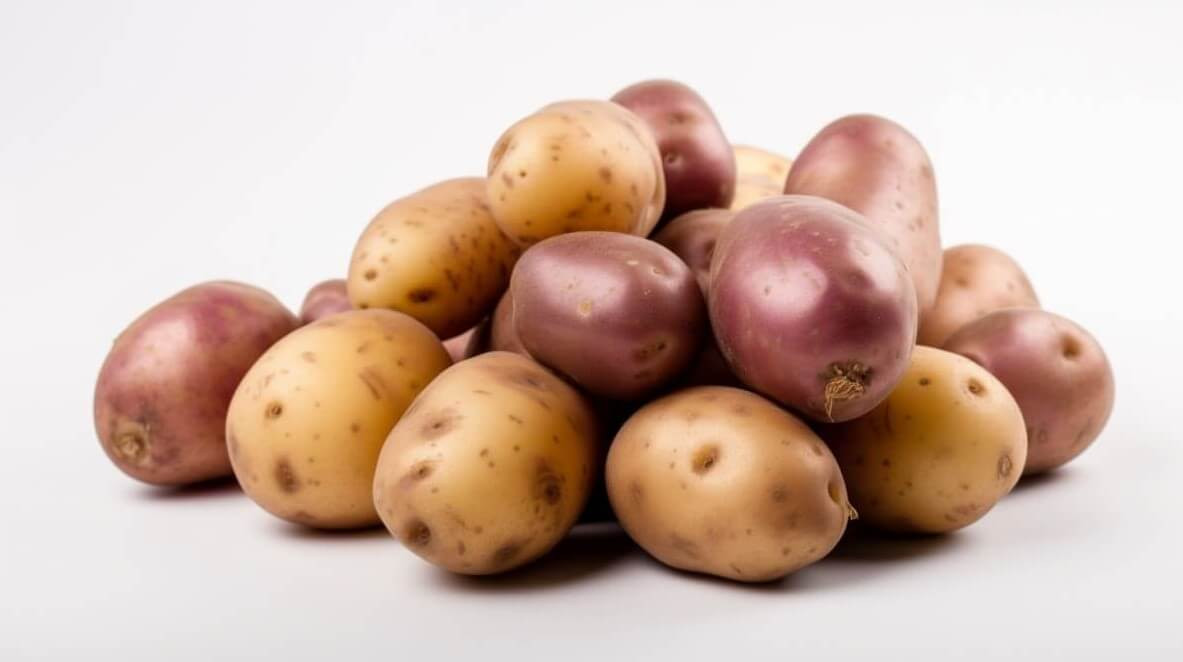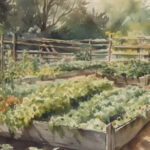(Early and maincrop potatoes)
Would you prefer to listen to a short podcast discussion about this article? Click on the audio below.
Potatoes are one of the most loved root vegetables in the UK. They come in different varieties and can be served in various ways – mashed, boiled, fried, baked or roasted. Growing potatoes in your home garden can be a rewarding experience, and it is easy to get started. In this article, we will guide you on how to grow early and maincrop potatoes.
Table of Contents

Understanding early and maincrop potatoes
Before we start planting, let’s first understand the difference between early and maincrop potatoes.
The humble potato is a staple food in many households and is one of the most versatile vegetables. They can be boiled, baked, fried, or roasted, and can be used in a variety of dishes.
When it comes to growing potatoes, there are two main types: early and maincrop. Both types have their unique characteristics and are suitable for different uses.
What are early potatoes?
‘Earlies’ are the first to be harvested and usually mature in June. These tend to be salad potatoes, and their flavour is sweeter and more delicate compared to the maincrop potatoes. Early potatoes are also known to grow quickly and are usually small in size.
Early potatoes are perfect for those who want to get a head start on their potato harvest. They are also ideal for those who have limited space in their garden, as they can be grown in containers or bags.
Some popular varieties of early potato includes Rocket, Swift, and Duke of York.
What are maincrop potatoes?
Maincrop potatoes take longer to mature, usually harvested between September and October. These are larger potatoes used for baking or boiling. Maincrop varieties tend to have a more robust and earthy flavour compared to their early counterparts.
A maincrop potato is perfect for those who want a larger yield and have more space in their garden. They are also ideal for those who want to store their potatoes for longer periods.
Some popular varieties of maincrop potatoes include Maris Piper, King Edward, and Desiree.
Differences between early and maincrop potatoes
The main differences between early and maincrop potatoes are the size, taste, and time of harvest. Early potatoes are smaller and sweeter; maincrop varieties are larger and have an earthy flavour. Earlies harvest in early summer, while main crop potatoes mature in late summer or early autumn.
When it comes to planting, the earlies should be planted in early spring, while maincrop potatoes should be planted in mid to late spring.
It’s important to note that both early and maincrop potatoes require well-drained soil and plenty of sunlight to grow. They also need to be watered regularly and fertilized to ensure a healthy yield.
Whether you choose to grow early or maincrop, both types are delicious and versatile. With a little bit of care and attention, you can enjoy a bountiful harvest of fresh, home-grown potatoes.
Choosing the right varieties
There are numerous potato varieties grown in the UK. Choosing the right variety can be overwhelming. Here are some popular early and maincrop varieties to consider:
Popular early potato varieties
- Swift
- Arran Pilot
- Charlotte
- Maris Bard
Popular maincrop potato varieties
- Maris Piper
- Cara
- King Edward
- Desiree
Factors to consider when choosing a variety
When selecting a potato variety, consider the following factors:
- The cooking method that you prefer
- Yield – some produce more than others
- The soil type in your garden – some varieties do better in specific soils
- Pest or disease resistance
Preparing the soil for planting
Now that you have chosen the potato variety, it is time to prepare the soil for planting. But before that, let’s take a closer look at what potatoes need to thrive.
Soil requirements for a potato
Potato varieties thrive in well-drained and fertile soil. The ideal pH is between 5-6.5. A potato does not do well in heavy clay soils – if your soil is heavy, then consider improving it before planting. A good way to improve the soil is by adding organic matter such as compost or well-rotted manure. This will not only improve the soil structure but also provide the necessary nutrients for the potato to grow healthy and strong.
It is also important to note that potatoes are heavy feeders. This means that they require a lot of nutrients to grow, so it is essential to ensure that the soil is rich in nutrients before planting.
Testing and amending the soil
Before planting, it is essential to test the soil to determine its nutrient levels accurately. You can buy a soil testing kit from a garden centre or submit a sample to a laboratory for analysis. This will help you determine the soil’s pH, nutrient levels, and other important factors that can affect potato growth.
If the nutrient levels are low, you can amend the soil by adding compost or well-rotted manure. This will help increase the soil’s fertility and provide the necessary nutrients for the potatoes to grow.
Preparing the planting area
Crop rotation is important; avoid planting a potato in the same spot for more than two years. This is because planting the same crops in the same spot can lead to the build-up of pests and diseases, which can affect potato growth and yield.
Choose a sunny spot and dig a trench, about 10cm deep and 60cm wide. Add a layer of compost or manure in the trench, then cover it and allow it to settle for a few days before planting. This will help the soil to absorb the nutrients and provide a good environment for the crop to grow.
It is also important to ensure that the soil is well-drained. This can be achieved by adding sand or grit to the soil, which will help improve drainage and prevent waterlogging.
By following these steps, you can ensure that the soil is well-prepared for planting potatoes. This will not only help improve potato growth and yield but also ensure that you have a healthy and thriving potato crop.
Planting early and maincrop varieties
If you’re a fan of the potato, then you know there’s nothing quite like the taste of fresh, home-grown spuds. Whether you’re planting early or maincrop varieties, there are a few things you need to know to ensure a successful harvest.
When to plant ‘earlies’
Earlies are the first potatoes of the season and are often referred to as “new potatoes”. They are usually smaller than maincrop potatoes and have a sweeter taste. ‘Earlies’ should be planted in March, preferably two to three weeks before the last expected frost. This gives them enough time to grow and mature before harvesting in June.
When choosing your early potato variety, look for ones that are quick to mature, such as ‘Rocket’ or ‘Swift’. These varieties are perfect for planting in containers or small gardens.
When to plant your maincrop varieties
Maincrop spuds are larger than earlies and take longer to mature. They are usually harvested in late summer or early autumn. Maincrop varieties should be planted in April or May; they require warmer soil to germinate. If planted too late, frost will damage the plants and reduce the yield.
When choosing your maincrop potato variety, look for ones that are disease-resistant, such as ‘Cara’ or ‘Desiree’. These varieties are perfect for planting in larger gardens or allotments.
Planting techniques and tips
Planting is relatively easy, but there are a few things to keep in mind to ensure a successful harvest.
First, prepare the soil by digging in plenty of organic matter, such as compost or well-rotted manure. This will help to improve the soil structure and provide the potatoes with the nutrients they need to grow.
Plant the seed potatoes about 30-40cm apart, with the shoots facing up. Cover them with a 10cm layer of soil. As the plants grow, mound soil around them, leaving only the top leaves exposed. This helps to protect the tubers from sunlight, which turns them green and inedible.
Water the plants well, especially during flowering and tuber development. Potatoes need much water to grow, so ensure the soil stays moist but not soggy.
If you’re growing them in containers, ensure they are large enough to accommodate the plants. A container that is at least 30cm deep and wide is ideal. Fill the container with a good-quality potting mix and plant a seed potato as you would in the ground.
Finally, keep an eye out for pests and diseases, such as potato blight. If you notice any signs of disease, remove the affected plants immediately to prevent the disease from spreading.
Growing spuds in your garden is a fun experience. By choosing the right variety, preparing the soil, and planting correctly, you can harvest a delicious crop of early and maincrop spuds.
If you are keen on organic gardening, check out The Soil Association website
If you need any further information or assistance with this article, don’t hesitate to Contact Us




















